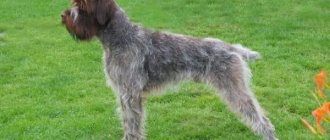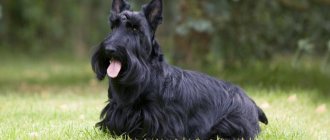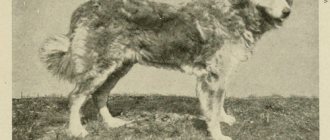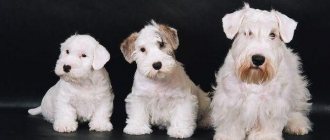Main characteristics
| Breed parameters | |
| Country of origin: | Scotland |
| Weight of the breed: | 6–10 kg |
| Height at withers: | 25–28 cm |
| Temperament: | active |
| Wool: | long |
| Role in human life: | companion, hunting |
| Breed group: | decorative |
The West Highland White Terrier is not inclined to behave aggressively towards close people. Even more - a small dog can become an excellent watchdog. Small dimensions do not allow the pet to stop the intruder. But with his loud barking, the dog is capable of alarming the entire neighborhood. For those who love perfect silence in the house, it is better to avoid keeping this breed.
History of the breed
There is little information about the origins of the West Highland White Terrier due to the age of the breed. The dog’s name literally translates as “white burrow dog from the western highlands.” At the same time, the word “Highland” refers to the largest region of Scotland - the homeland of the pet. The name of the region fully reflects the mountainous landscape of these places.
There are written sources from the 12th century containing references to the ancestors of snow-white dogs. Even then, the predecessors of the "Vestiki" helped people hunt game. It should not be surprising that the hunting instinct of a domestic animal is so strong. Experts are confident in the earlier formation of the breed. But no written or material evidence of this has yet been discovered.
Initially, dogs were bred to hunt small animals such as badgers and otters. It is believed that the favorites were bred on the basis of two other relatives: Scotch and Cairn terriers. At first, the color of the dog’s coat was more varied, and a completely white color was considered a defect. Breeders considered such puppies to be sickly and got rid of them.
Purposeful breeding of white dogs began only towards the end of the 19th century. Hunters noticed that the snow-white dog is easy to spot in the grass and difficult to confuse with a wild animal. In the confusion, a person could accidentally shoot a pet, confusing it for the purpose of hunting. And it was not difficult to see white dogs even in the evening.
When exactly the West Highland White Terrier dog arose in its modern form is not known for certain. But the first club of breed lovers arose in Scotland in 1904. The Westie became an independent breed of terrier two decades later, in 1924.
Colonel Edward Malcolm and Duke George Campbell made a huge contribution to the breeding of snow-white dogs. It was these people who specifically looked for white puppies, breeding animals on their estates.
How to choose a dog
Westies are becoming more and more popular and unscrupulous people are profiting from the sale of pseudo-pedigreed puppies.
Therefore, never buy a dog at the market.
Even if you are lucky and the purchased puppy turns out to be healthy, it will not necessarily grow up to be a West Highland dog and not an ordinary white mongrel.
Contact well-known nurseries with a good reputation that have been working with the breed for several years.
In this case, you will be able to receive all possible assistance in raising and raising a puppy, see the baby’s parents and make sure that the West Highland White Terrier puppies were raised in good conditions.
Choosing a puppy is a very responsible matter.
Experienced dog breeders recommend choosing not the largest puppy from the litter, but the most nimble, active and inquisitive one.
Carefully examine the baby: he should have clear eyes, without any discharge, a clean, moist nose, clean and pink ears.
The belly should not be bloated and there should be no signs of loose stool under the tail.
Photo of West Highland White Terrier
Breed standard
In appearance, the breed is slightly reminiscent of a Bichon Frize. The pet appears decorative in the photo, but is not fragile in reality. The dog is distinguished by its white coat, which has a pronounced undercoat and is hard to the touch.
The external characteristics of the breed are as follows:
- Head. The wide skull is slightly convex. The stop (the transition from the forehead to the muzzle) and the brow ridges are clearly defined.
- Muzzle. The distance from the back of the head to the eyes should be greater than from the tip of the nose to the stop.
- Ears. Small, with sharp ends. They are set on the head at a moderate distance from each other, covered with hair on the outside.
- Nose. The nose is black and large, practically not protruding beyond the muzzle.
- Eyes. They are located widely in relation to each other, set deep in the eye sockets. Almond shape. The iris of the eye has the darkest color possible.
- Jaws. The pet has powerful jaws, despite its small size. Scissor bite.
- Body. Compact body. Straight back, deep chest and wide croup. The loin is strong, with a slightly tucked belly.
- Neck. Medium length, quite muscular. Smoothly passes, thickening, into the body.
- Forelegs. Short, parallel. They have well-developed muscles. A slight, slight inversion of the limbs is acceptable. This is explained by the consequences of the frequent digging practiced by the ancestors of domestic animals.
- Hind limbs. Strong and sinewy, thickened at the top.
- Paws. The front legs are larger than the hind legs. The fingers are tightly pressed together, forming a rounded shape. The pads are black.
- Tail. No more than 15 cm long. The dog raises its tail vertically when walking.
Breed standard and description
The magnificent West Highland White Terrier, whose breed description includes a number of significant nuances, is similar in appearance to a plush toy. This compact animal has a fairly muscular body. The height at the withers is on average 27 centimeters with a weight of 8 kilograms.
The breed standard includes the following characteristics:
- The dog's body is large and muscular, the loin is wide. Shoulders and croup are powerful and wide;
- limbs are short, powerful, muscular. The paws are small, collected in a ball, the claws and pads are black;
- tail length averages 16 centimeters;
- the head is round and large. The neck is quite short, the muzzle is blunt, the brow ridges are massive. The jaws are strong, the bite is straight;
- the ears are small, triangular in shape, stand straight;
- the eyes are slightly convex, medium-sized, dark in color;
- the coat is medium length, straight, with a thick undercoat;
- The color is white, there may be a cream tint.
Maintenance and care
The West Highland White Terrier dog requires careful grooming. If you don’t have enough time or money for haircuts, it’s better to stick to a short-haired breed. With poor care, the fur becomes clumps. In advanced situations, such tangles provoke skin diseases.
Pet grooming should be divided into several activities:
- Combing. Your pet's fur should be brushed every 24 hours. You should use a metal brush, since the Vestik's hair is quite hard. Regular brushing helps remove dead hair and promotes good blood circulation.
- Trimming. The procedure involves removing old, thinning hairs by plucking. Help is needed because hair does not fall out on its own. This feature can be a plus - dogs shed little. The dog will need the services of a trimmer 2 times a year.
- A haircut. If the dog is not a show dog, the hair can simply be cut at a grooming salon. It is possible to cut your hair at home (if you have the slightest experience in this matter). However, trimming has a number of advantages over a regular haircut.
- The washing up. A pet's fur is tough, so it repels most dirt. This also determines the cleanliness of the “news”, which has practically no smell. Animals not intended for exhibitions are washed rarely - 3-4 times a year. But paws must be washed after every walk.
We must not forget about the standard procedures necessary for all dogs: cleaning of teeth, eyes and ears. Nails need to be trimmed approximately once every 4 weeks - it is preferable to use a nail clipper for trimming.
White West is perfect for keeping in an apartment. But active games and long walks are mandatory for all hunting dogs. If the pet lives in a private house, then it can walk in the backyard. At the same time, the pet should not have access to flower beds or a vegetable garden, otherwise digging cannot be avoided.
The dog can only tolerate short periods of loneliness. The owner should not leave the pet alone for a long time. Loneliness is fraught with bad habits such as damaging things or frequent barking.
Even if you have your own plot, walking surrounded by other people cannot be completely replaced. From a young age, the puppy should see strangers and other dogs. A dog that has not been in contact with its environment as a child will become suspicious of any living creature.
History of the breed
The pure modern breed got its history at the beginning of the last century. In the early 90s, Argyll's feast Niall Campbell founded the first club. Behind them, the Countess of Aberdeen and Edward Malcolm, who bred white-haired animals, founded a second community. A scandal was brewing between the vice-presidents of the two clubs, and in 1903 Malcolm began to deny his involvement in the development of the dog breed. By the end of 1906, the West Highland White Terrier was known to all the nobility of Great Britain; they called the cute dogs “Potalloch Terriers”, this was the name of the lands over which Malcolm controlled. The landowner, due to his political views, completely refused further participation in the ennoblement of the breed, transferring leadership into the hands of the Countess of Aberdeen.
1908 became the official date of recognition of the breed in England; dogs had already begun to be imported to the USA, where they received the approval of dog handlers and critics. In the United States, the name West Highland White Terrier has been documented. The bohemian public immediately fell in love with the nimble and funny little ones. They were associated with the aristocracy. Only noble people could afford such pets, since their import was somewhat complicated, and it was practically impossible to breed pure white animals. Dogs were especially revered in France. By the middle of the 20th century, the breed earned its place in the top three common breeds.
West Highland White Terrier - fearless hunter
Nutrition
The West Highland breed does not have any particular eating habits. The only peculiarity is the tendency of the Westies to allergies. If your pet has an allergic reaction, dog food is selected together with a veterinarian.
A good indicator that tells everything about the physical condition of a pet is fur. Hair turns yellow when food contains a lot of additives, dyes, and unnatural ingredients.
Dry food does not mix with natural food. You should not give your West Highland wheat flour or chicken. Even when purchasing dry food, it is better to make sure that these products are not included. Giving any sweets or smoked foods to dogs that like to beg is prohibited. You can treat your animal only with special dog treats.
Health: common diseases
West Highland dogs cannot be classified as particularly problematic dogs. In most cases, the health condition remains satisfactory until the dog gets older. But, like all domestic animals, the Westie has its own list of common diseases.
The list of common diseases includes:
- eye diseases (cataracts, entropion, retinal atrophy);
- allergies, fungi, skin tumors (especially with poor coat care);
- joint diseases (dysplasia, craniomandibular osteopathy);
- heart disease (cardiomyopathy);
- problems with the endocrine system (chronic hyperglycemia);
- meningoencephalitis of white dogs.
Compared to other terriers, Westies are less susceptible to serious illnesses. This also applies to hereditary diseases.
Health and illness
West Highland White Terriers rarely complain about their health; they are a fairly healthy breed. An exception may be living conditions and specific diseases characteristic of these individuals.
This may include:
- atopy
- yeast dermatitis
- pulmonary fibrosis
- food allergies
- diabetes
- cutaneous histiocytoma
- aseptic necrosis of the femoral head
- keratoconjunctivitis and cataracts
- cardiomyopathy
- hip dysplasia
- craniomandibular osteopathy
- congenital deafness and meningoencephalitis of white-haired
Much less often, these small dogs have pathologies such as disruption of the interventricular septum, hypertrophy of the right ventricle with stenosis of the pulmonary trunk.
Pros and cons of the breed
Having considered the description of the breed and character, you can make a short list of the pros and cons of these pets. The described pets are hunting animals - we must not forget about the roots of the dog. Some stubbornness is the basis of the character of hunting dogs.
The advantages include the following characteristics:
- lack of tendency to aggression;
- friendliness and playfulness;
- endurance on long hikes;
- weak shedding;
- good communication skills;
- suitable for living in an apartment;
- can be used as a guard.
The pet also has several disadvantages:
- habit of digging up the ground;
- expensive grooming;
- incompatibility with young children.
A socialized, properly raised Westie will always be happy to have the company of people. The dog can be considered one of the extroverts of the canine world. In adulthood, the animal maintains the same level of activity, happily spending time playing with its owner.
Photos of West Highland White Terrier puppies
Choosing a puppy
You can avoid breeders who try to sell a sick puppy cheaply by making a purchase from a kennel. It is necessary to choose an official establishment registered in the RKF. When it comes to choosing a West Highland White puppy, a lot depends on the type of breeder. Those who refuse to support the new owner during the dog’s adaptation period should be avoided.
You need to pay attention to the behavior of the puppy itself. A small pet should behave actively and move - this indicates good health. You should palpate your abdomen for swelling. If there is a protruding area, there is a risk of developing an umbilical hernia. Responsible breeders provide test results for hereditary diseases.
The owners note that the gender of a puppy of this breed does not affect its character. But there is an opinion that males learn faster than females.
And also when choosing a puppy it is advisable to:
- evaluate the conditions in which pets are kept;
- meet the puppies' parents;
- see several litters from different parents.
Pedigree Westie puppies cost from 25 to 45 thousand Russian rubles. This price is set for a pet class not intended for exhibitions. The most expensive puppies are show class. The cost of such pets starts from 80 thousand rubles and can rise even higher.
Attitude towards children
This breed is more suitable for families where the children are older. These little proud bosses will not always accept a child who is less than 10 years old. They will not tolerate their games, and sometimes they may begin to be jealous of their owners. In addition, children can harm a small dog, so you should take this nuance into account when choosing a pet.
West Highland White Terrier - features, character and diseases of the breed











